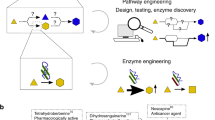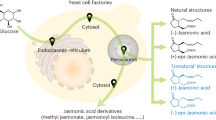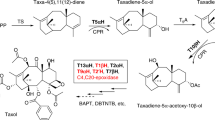Abstract
We transformed an alkaloid biosynthetic gene with reengineered substrate specificity into Catharanthus roseus. The resulting transgenic plant cell culture produced a variety of unnatural alkaloid compounds when cocultured with simple, achiral, commercially available precursors that the reengineered enzyme was designed to accept. This work demonstrates the power of genetic engineering to retailor the structures of complex alkaloid natural products in plant culture.
This is a preview of subscription content, access via your institution
Access options
Subscribe to this journal
Receive 12 print issues and online access
$259.00 per year
only $21.58 per issue
Buy this article
- Purchase on Springer Link
- Instant access to full article PDF
Prices may be subject to local taxes which are calculated during checkout

Similar content being viewed by others
References
Ganesan, A. Curr. Opin. Chem. Biol. 12, 306–317 (2008).
Menzella, H.G. & Reeves, C.D. Curr. Opin. Microbiol. 10, 238–245 (2007).
Yun, D.-J., Hashimoto, T. & Yamada, Y. Proc. Natl. Acad. Sci. USA 89, 11799–11803 (1992).
Ye, X. et al. Science 287, 303–305 (2000).
Katsuyama, Y., Funa, N., Miyahisa, I. & Horinouchi, S. Chem. Biol. 14, 613–621 (2007).
Schmidt-Dannert, C., Umeno, D. & Arnold, F.H . Nat. Biotechnol. 18, 750–753 (2000).
O'Connor, S.E. & Maresh, J.J. Nat. Prod. Rep. 23, 532–547 (2006).
Minami, H. et al. Proc. Natl. Acad. Sci. USA 105, 7393–7398 (2008).
Hawkins, K.M. & Smolke, C.D. Nat. Chem. Biol. 4, 564–573 (2008).
Bernhardt, P., McCoy, E. & O'Connor, S.E. Chem. Biol. 14, 888–897 (2007).
Ma, X. et al. Plant Cell 18, 907–920 (2006).
Chen, S., Galan, M.C., Coltharp, C. & O'Connor, S.E. Chem. Biol. 13, 1137–1141 (2006).
Loris, E. et al. Chem. Biol. 14, 979–985 (2007).
Toivonen, L., Balsevich, J. & Kurz, W.G.W. Plant Cell Tissue Organ Cult. 18, 79–93 (1989).
Hughes, E.H., Hong, S.-B., Shanks, J.V., San, K.-Y. & Gibson, S.I. Biotechnol. Prog. 18, 1183–1186 (2002).
Acknowledgements
We gratefully acknowledge J. Shanks and C. Peebles (Iowa State) for detailed advice in the transformation procedure. CAMBIA is acknowledged for providing the pCAMBIA vectors, and N.-H. Chua (Rockefeller) is acknowledged for providing pTA7002. We thank L. Smeester (MIT) for assistance with rt-PCR, J.J. Maresh (MIT) for helpful discussions regarding the Agrobacterium transformation and N. Nims (MIT) for helpful suggestions regarding primer design for rt-PCR experiments. N. Yerkes (MIT) generously provided strictosidine standards. We thank T. Kutchan (Danforth Plant Science Center) for suggesting the pCAMBIA vector system. We gratefully acknowledge J. Simpson's (MIT) assistance in obtaining two-dimensional NMR data. This work was supported by the US National Science Foundation (MCB0719120). We acknowledge the US National Institutes of Health and the American Cancer Society for additional support.
Author information
Authors and Affiliations
Contributions
W.R. designed and performed all experiments and contributed to data analysis and manuscript writing. S.E.O. was the principal investigator of the project, contributed to data analysis and manuscript writing and provided funding.
Corresponding author
Supplementary information
Supplementary Text and Figures
Supplementary Figures 1–7, Supplementary Table 1 and Supplementary Methods (PDF 1636 kb)
Rights and permissions
About this article
Cite this article
Runguphan, W., O'Connor, S. Metabolic reprogramming of periwinkle plant culture. Nat Chem Biol 5, 151–153 (2009). https://doi.org/10.1038/nchembio.141
Received:
Accepted:
Published:
Issue Date:
DOI: https://doi.org/10.1038/nchembio.141
This article is cited by
-
March of molecular breeding techniques in the genetic enhancement of herbal medicinal plants: present and future prospects
The Nucleus (2022)
-
Unnatural spirocyclic oxindole alkaloids biosynthesis in Uncaria guianensis
Scientific Reports (2019)
-
Furan-Site Bromination and Transformations of Fraxinellone as Insecticidal Agents Against Mythimna separata Walker
Scientific Reports (2018)
-
Mevalonate-derived quinonemethide triterpenoid from in vitro roots of Peritassa laevigata and their localization in root tissue by MALDI imaging
Scientific Reports (2016)



